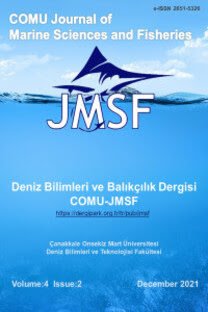Sierra Leone'de Karides Balıkçıları Tarafından Avlanan Pembe Karides, Farfantepenaeus notialis İçin Biyolojik Referans Noktalarının Tahmin Edilmesi
Bayesian, Yararlanma oranı, Avcılık baskısı, Referans noktası, Stok, Sürdürülebilirlik
Estimating Biological Reference Points of the Pink Shrimp, Farfantepenaeus notialis (Perez-Farfante, 1967) Targeted by Shrimp Trawlers in Sierra Leone
Exploitation, Fishing Pressure, Stock, Sustainability, Bayesian, Referance point,
___
- Alam, M.S., Liu, Q., Nabi, M.R.-U., & Al-Mamun, M.A. (2021). Sustainability, 13, 3604. https://doi.org/10.3390/su13073604.
- Amorim, P., Sousa, P., Jardim, E. & Menezes, G.M. (2019) Sustainability Status of Data-Limited Fisheries: Global Challenges for Snapper and Grouper. Frontiers in Marine Science, 6, 654. doi: 10.3389/fmars.2019.00654
- Coutin, P.C., & Payne, A.I. (1989). The effects of long-term exploitation of demersal fish populations off the coast of Sierra Leone, West Africa. Journal of Fish Biology, 35, 163–167.
- Froese, R., Zeller, D., Kleisner, K., & Pauly, D. (2012). What catch data can tell us about the status of global fisheries? Marine Biology, 159, 1283–1292.
- Froese, R. (2018). New Methods for Estimating the Status of Data-poor Fisheries (pp.38). Aquatic Ecosystems Research Laboratory, GEOMAR, GEOMAR, Germany.
- Froese, R., Demirel, N., Coro, G. & Winker, H. (2021). User Guide for CMSY++. (pp.17). Aquatic Ecosystems Research Laboratory, GEOMAR, Germany. Accessed online at http://oceanrep.geomar.de/52147/.
- Gillett, R. (2008). Global study of shrimp fisheries (pp.331). FAO Fisheries Technical Paper.
- Gulland, J. (1971). The Fish Resources of the Ocean (pp.255). FAO Fishing News Books, Surrey.
- King, M.G. (2007). Fisheries biology, assessment and management (pp.189-194). Wiley-Blackwell Publishing Ltd.
- Konoyima, K.J. (2021). Evaluating Size at Sexual Maturity and Size-Structure of Farfantepenaeus notialis in Sierra Leone. Journal of Pure and Applied Sciences, 13 (2), 7-14
- May-Kú, M.A., Ordóñez-López, U., & Defeo, O. (2006). Morphometric differentiation in small juveniles of the pink spotted shrimp (Farfantepenaeus brasiliensis) and the southern pink shrimp (F. notialis) in the Yucatan Peninsula. Mexico Fish Bulletin, 104, 306–310.
- Meissa, B., Dia, M., Baye, B.C., Bouzouma, M., Beibou, E. & Roa-Ureta, R.H. (2021) A Comparison of three data-poor stock assessment methods for the Pink Spiny Lobster Fishery in Mauritania. Frontiers in Marine Science, 8: 714250. doi: 10.3389/fmars.2021.714250.
- Nwosu, F. (1008). Population Dynamics of the Exploited Penaeid Shrimp, Penaeus (Farfantepenaeus notialis) in the Cross River Estuary, Nigeria. Journal of Fisheries International, 4(4), 62-67. doi: 10.3923/jfish.2009.62.67.
- Pauly, D., & Zeller, D. (2016). Catch reconstructions reveal that global marine fisheries catches are higher than reported and declining. Natural Communication, 7, 10244.
- Shan, X., Jin, X., Dai, F., Chen, Y., Yang, T., & Yao, J. (2016). Population Dynamics of Fish Species in a Marine Ecosystem: A Case Study in the Bohai Sea, China. Marine and Coastal Fisheries, 8(1): 100-117. https://doi.org/10.1080/19425120.2015.1114543
- Showers, P.A.T. (2012). The shrimp stocks of Sierra Leone. In: Vakily J.M, Seto, K. and Pauly, D. (Eds.). The Marine Fisheries Environment of Sierra Leone. (pp. 46–49). Fisheries Centre Research Reports 20 (4). Fisheries Centre, University of British Columbia.
- Showers, P.A.T. (1999). Escalation in shrimp production in the Sierra Leone industrial fishery. NAGA, 22 (3), 29-31.
- Winker, H., Carvalho, F., Sharma, R., Parker, D., & Kerwath, S. (2017). Initial results for north and south Atlantic shortfin Mako (Isurus oxyrinchus) stock assessments using the Bayesian surplus production model JABBA and the catch-resilience method CMSY. ICCAT, 74, 1836–1866.
- Zhang, L. (2021). Global Fisheries Management and Community Interest. Sustainability, 13, 8586. https://doi.org/10.3390/su13158586.
- Yayın Aralığı: Yılda 2 Sayı
- Başlangıç: 2018
- Yayıncı: Çanakkale Onsekiz Mart Üniversitesi Deniz Bilimleri ve Teknolojisi Fakültesi
Türk Boğazlar Sistemi Balıkçılarının Seyir Emniyeti ve Denizde Emniyet Farkındalıklarının Ölçülmesi
Komba Jossie KONOYİMA, Percival Arthur Timothy SHOWERS
Su Ürünleri İşleme Endüstrisi İçin Bir Seçenek: Elektrolize Sular
Deniz Kestanesi Paracentrotus lividus’un Gökçeada Kıyılarındaki Bolluğu
Kuzeydoğu Akdeniz Dip Trol Balıkçılığında Karides Türlerinin Av Kompozisyonu ve Verimliliği
Yusuf Kenan BAYHAN, Erdogan ÇİÇEK, Tarık ÜNLÜER, Mehmet ÖZDÖL
Okan AKYOL, Halil ŞEN, Christian CAPAPÉ
Erhan MUTLU, Ilaria DE MEO, Claudia MİGLİETTA, Mehmet Cengiz DEVAL
Farklı Yemlerle Tuz Karidesi, Artemia parthenogenetica Üretiminin Değerlendirilmesi
Abdolsaleh QARANJIKI, Mine KIRKAĞAÇ
Mersin Bölgesindeki Balıkçı Gemilerinde Çalışanların Maruz Kaldığı Gürültü Kirliliğinin Belirlenmesi
Gökhan Teyfik GÖÇER, Alkan ÖZTEKİN
